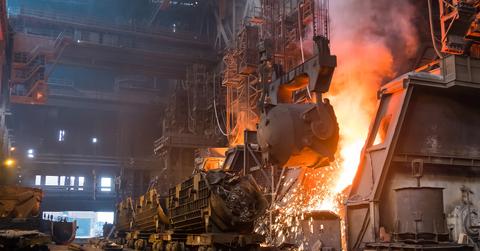CLF Acquires AKS: A Match Made in Heaven?
Yesterday, Cleveland-Cliffs (CLF) announced that it would acquire AK Steel (AKS) at a premium of 16% over both stocks’ December 2 closing prices.
Dec. 5 2019, Updated 4:25 p.m. ET

- Yesterday, Cleveland-Cliffs (CLF) announced that it would acquire AK Steel (AKS) at a premium of 16% over both stocks’ December 2 closing prices. After the acquisition, the combined entity would become an integrated steel producer.
- Cleveland-Cliffs stock slumped 10.7% while AK Steel gained 4.2% in yesterday’s trading.
CLF acquires AKS
Yesterday, CLF announced that it would acquire AKS in a stock-for-stock transaction. After the acquisition, Cleveland-Cliffs would obtain access to AK Steel’s steelmaking operations. Currently, CLF is an iron ore miner supplying US steel companies. AK Steel, on the other hand, is a steel producer with primarily flat rolled operations. However, it also produces electrical steel, a niche and a value-added product.
Notably, while U.S. Steel (X) has its own iron ore mines, AK Steel sources steel from third parties. While CLF stock fell sharply after the announcement, AKS closed with gains. Read CLF Buys AK Steel: A Win-Win Transaction? for a broad overview of the transaction. In this article, we’ll look at the key details from the conference call.
Key details
On a broad strategic level, this transaction is a forward integration for CLF. Along with iron ore, CLF would now get steelmaking operations as well. That’s not unheard of in the steel and iron ore industry, and U.S. Steel and ArcelorMittal (MT) are integrated steel companies having varying degrees of backward integration.
While the strategic rationale for the deal looks solid, markets seem concerned about the financial aspects. For instance, AK Steel has much higher relative debt and pension liabilities. AKS also has a good amount of near-term debt maturities.
CLF versus AKS
AK Steel’s profit margins are also much lower when compared to Cleveland-Cliffs. AK Steel’s income statement and balance sheet are weaker compared to CLF. During the call, CLF CEO Lourenco Goncalves said that while the company is acquiring AK Steel at an EV-to-EBITDA of 5.6x, the company’s 2020 EV-to-EBITDA is 8.6x based on consensus earnings estimates.
Notably, AK Steel’s 2020 earnings are expected to be lower than in 2019 due to lower contract pricing. That said, the deal could still make sense for CLF. Let’s discuss this in perspective.
Synergies and earnings accretive
CLF expects to realize annual synergies of $120 million from the transaction. In the pro forma numbers that it prepared, AK Steel’s margins rose from 8.1% to 15.0% in the nine-month period ending September 30, 2019.
Given CLF’s stronger balance sheet, it expects to refinance AK Steel’s debt at better terms and also push out upcoming maturities. Notably, Moody’s is reviewing CLF’s credit rating for a downgrade but sees the transaction as credit positive for AK Steel.
Then there are possible new lines of business, like exploring pig iron production at AK Steel’s idled Ashland Works plant. CLF’s current CEO has turned the company around over the last five years, and we expect this experience to benefit AK Steel as well.
In my view, the transaction makes strategic sense, and AK Steel would have more certainty about its iron ore purchases with CLF’s iron ore operations. While Cleveland-Cliffs stock has come under short-term pressure due to the deal’s valuation that gives a premium to AKS shareholders, the transaction should create long-term value for CLF shareholders.
